Research Resources and Analytical Facility
College-Based Research Resources
Molecular Modeling Laboratory
The Molecular Modeling Laboratory is employed to find new pharmaceutical agents as well as to correct problems with existing drugs. Utilizing state of the art Silicon Graphics computers, researchers can view and alter molecular structures much less expensively than in the traditional laboratory environment. The traditional alteration of a molecule may involve numerous laboratory processes leading to the synthesis of many molecules. With the computer, scientists can change molecular structures with a reasonable idea of the corresponding pharmacological changes. For example, if an existing drug has a particular troublesome side effect, the molecular structure can be modified to maintain the original efficacy, while decreasing the side effect.
Liquid Chromatography-Mass Spectroscopy Facility
The department recently added a state-of-the-art LCMS systems: the API-3000. Together with the existing Bruker Esquire LCMS system, it constitutes the shared LCMS facility of the department. The Bruker Esquire-LC Ion Trap LC/MS(n) system is located in room 310, Faculty building of the Department of Pharmaceutical Sciences. Mass range m/z can be measured from 50 up to 6000 with high resolution and high sensitivity. Multiple fragmentation (MS/MS) of analyte molecule can go up to MS6 for structural elucidation. Coupled with HP 1100 Chemstation and the robust, versatile software running on Windows NT, the LC-MS system is an extremely powerful and indispensable instrument for life science researches. The API 3000™ LC/MS/MS System is an enhanced high performance triple quadrupole mass spectrometer with applications in protein and peptide analysis, small molecule analysis in drug metabolism and pharmacokinetic studies, and n-in-one cassette dosing analysis. It is located in 4P in the Crowe Building.
Nuclear Magnetic Resonance Facility
The Department of Pharmaceutical Sciences has modern equipment for the performance of a wide range of experimental procedures. One of the newest and most expensive pieces of equipment is a Varian Unity Inova 500MHz NMR, located in room 107 Johnson Building. This instrument and another upgraded Bruker ARX-300MHz NMR forms the NMR lab in the Health Science Center. These state-of-the-art instruments are available to members of the department for qualitative and quantitative purposes, and it is presently used primarily to determine the structure of drug molecules, protein/DNA structure elucidation and combinatorial chemistry studies. The NMR is a very powerful tool in determining the structure of complex natural materials and synthetic organic substances. Routine multinuclear multidimensional NMR capabilities are available, as well as flow probe for High Throughput Screen (HTS) studies and Nanoprobe for semi-solid and tissue studies. For more information, contact Wei Li.
College of Pharmacy Core Facilities and OtherInstitutional Core Facilities and ResourcesAnalytical Facility
The Analytical Facility for the University of Tennessee Health Science Center College of Pharmacy houses 2 NMR spectrometers (500 and 400 MHz) and 4 mass spectrometers as well as a couple of HPLC, UV, IR, and polarimeter instruments. It is the largest available state-of-art analytical and bioanalytical facility for researchers at UT Health Science Center. The facility provides critical analytical/bioanalytical support to a broad spectrum of research in drug discovery, including medicinal chemistry, drug metabolism and pharmacokinetics (DMPK), drug delivery, formulation, and other bioanalytical work.
| Instrument Name | Location | Year Acquired | Probes | Image |
|---|---|---|---|---|
| Varian Inova 500 | Pharmacy Room B024 | 2001 |
|
 |
| Bruker Avance III 400 | Pharmacy Room B024 | 2011 | 5mm BBO | 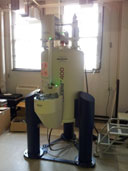 |
| Instrument Name | Location | Year Acquired | Ion source(s)/Analyzer | Image |
|---|---|---|---|---|
| Waters Xevo G2-S QTOF | Pharmacy Room 502 | 2012 | ESI/APCI Quadrupole TOF | 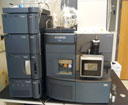 |
| AB Sciex API-4500 with Shimadzu Nexera X2 UPLC | Pharmacy Room 419 | 2013 | ESI/APCI Triple-Quadrupole | 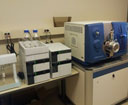 |
| SCIEX TQ5500 with Shimadzu Nexera XR HPLC | Pharmacy Room 421 | 2014 | ESI/APCI Triple-Quadrupole |  |
| Bruker amaZon SL Mass Spec with Shimadzu HPLC | Pharmacy Room 502 | 2016 | ESI/Ion Trap | 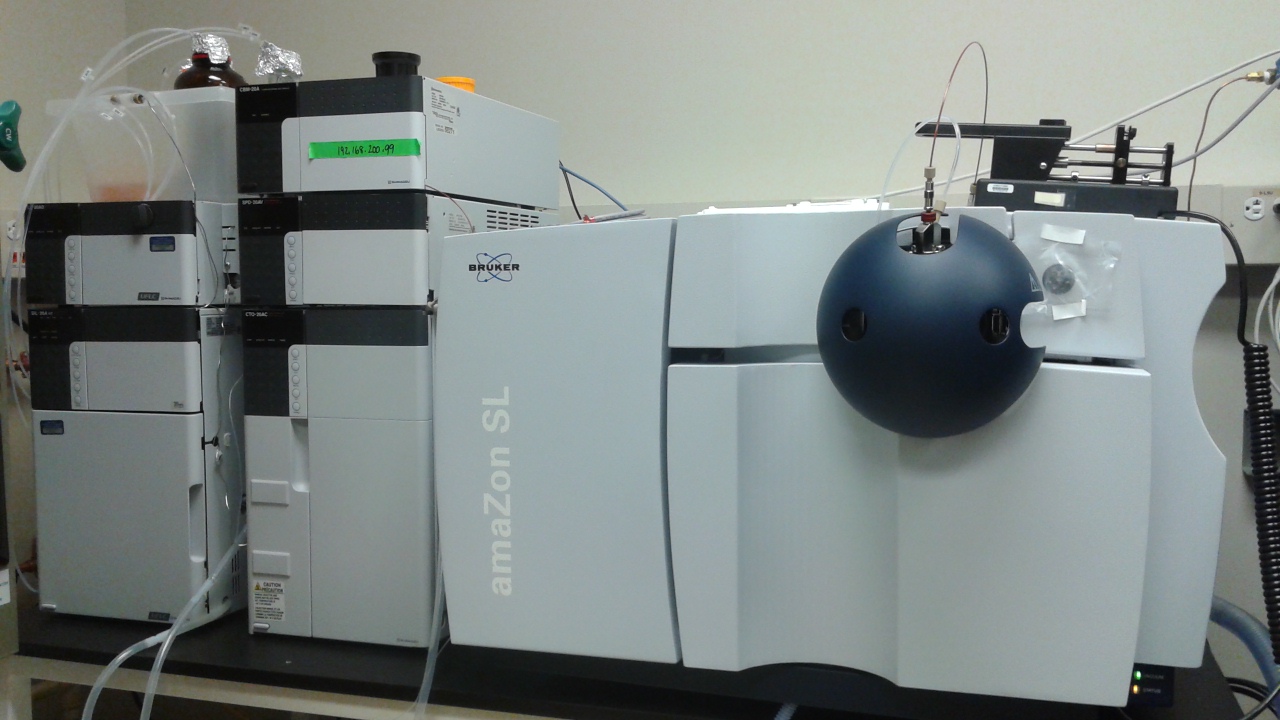 |
| *Waters SYNAPT G2-Si HDMS with ACQUITY M-Class UPLC and Progenesis QIP software | Pharmacy Room 415 | 2017 | Nanoelectrospray/QTOF with ion mobility | 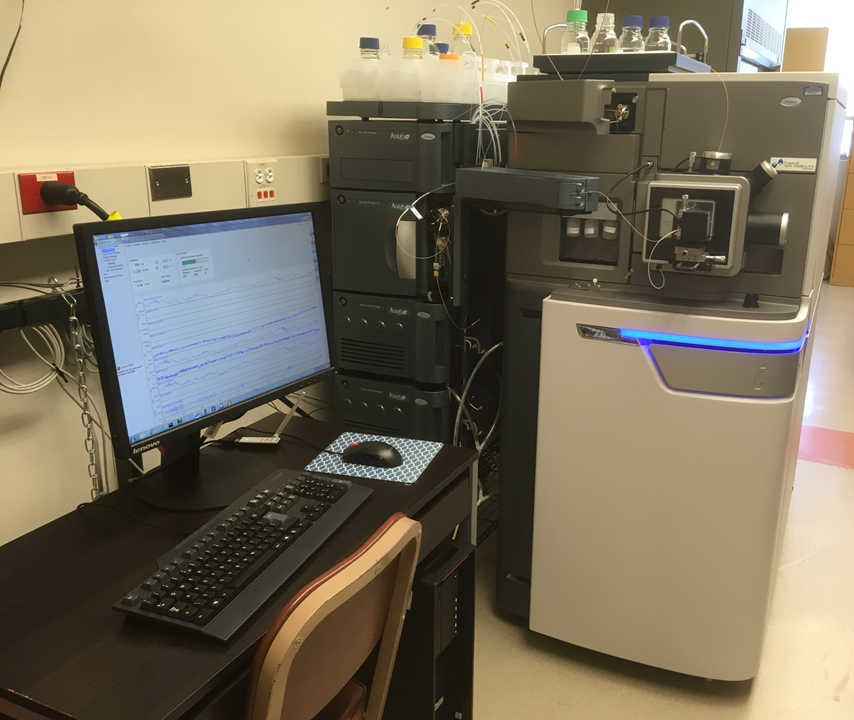 |
| Instrument Name | Location | Year Acquired | Application | Image |
| Bruker BioScope Resolve | Pharmacy Room B025 | 2018 | High resolution imaging | 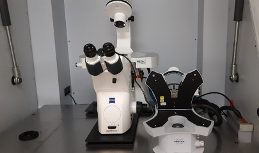 |
| Instrument Name | Location | Year Acquired | Features & Application | Image |
|---|---|---|---|---|
| Gilson preparative HPLC with waters Acquity UPLC | Pharmacy Room 502 | 2001 | UV and Fraction collector | 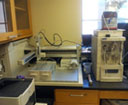 |
| Perkin-Elmer FT IR | Pharmacy Room 502 | 2011 | Fourier transform infrared spectroscopy |  |
| Varian Cary 1E UV | Pharmacy Room B024 | 1995 | UV absorption | 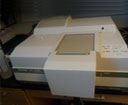 |
| Rudolph Autopol V Polarimeter | Pharmacy Room B024 | 2013 | Optical rotation measurement | 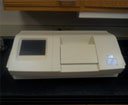 |
| Manufacturer | Agilent (Santa Clara California, USA) |
|---|---|
| Specifications |
|
| Probes |
|
| Software | Linux based VNMRJ |
| Applications |
|
| Manufacturer | BrukerBiospin (Billerica, MA, USA) |
|---|---|
| Specifications |
|
| Probes |
|
| Software | Topspin 3.0 on Windows 7 |
| Applications |
|
| Manufacturer | Waters (Milford, MA, USA) |
|---|---|
| Ionization modes | Positive and negative (ESI and APCI by direct infusion or LCMS, and Solid Analysis Probe) |
| Analyzer/detector |
|
| Operating modes |
|
| M/Z range | 20-100,000 Da |
| Resolving power | 30,000 FWHM |
| Mass Accuracy | ±1ppm |
| Inlets | Waters Acquity I-Class UPLC including:
|
| Software | Masslynx 4.1 on Windows 7 |
| Applications |
|
| Manufacturer | AB Sciex (Foster City, CA, USA) |
|---|---|
| Ionization modes | Positive and negative (Turbo V source with ESI and APCI) by direct infusion or LCMS |
| Analyzer | Triple quadrupole (QJet® 2 Ion Guide delivers 10x higher sensitivity over API-3000) |
| Operating modes |
|
| M/Z range | Up to 2000 Da |
| Resolving power | Unit mass resolution |
| Mass Accuracy | ±0.2u |
| Inlets |
|
| Manufacturer | Waters (Milford, MA, USA) |
|---|---|
| Ion Source/Analyzer | Nanoelectrospray/QTOF with ion mobility |
| Analyzer | QTOF with ion mobility |
| Performance Attributes |
|
| Main Application | Qualitative and quantitative proteomics |
| Note | This instrument is available for collaborative research projects. Please contact Drs. Beranova (sberanova@uthsc.edu) or Giorgianni (fgiorgia@uthsc.edu) to discuss your biological mass spectrometry interests and needs. |
| Manufacturer | Sciex (Framingham, MA, USA) |
|---|---|
| Ionization Modes | Positive and negative (Turbo V source with ESI and APCI) by direct infusion or LCMS |
| Analyzer | Triple quadrupole (QJet® 2 Ion Guide) |
| Operating Modes |
|
| M/Z Range | Up to 1000 Da |
| Resolving Power | Unit mass resolution |
| Mass Accuracy | ±0.2u |
| Inlets |
|
| Manufacturer | Bruker Daltonics (Billerica, MA, USA) |
|---|---|
| Ionization Modes | Positive and negative (ESI) by direct infusion or LCMS |
| Analyzer | Ion trap |
| Operating Modes | Full scan MS and MSMS |
| M/Z Range | Up to 2200 Da |
| Resolving Power | Unit mass resolution |
| Mass Accuracy | 0.2 u |
| Software | Compass 1.7 for amaZon with trapControl 7.2, HyStar 3.2, and DataAnalysis 4.2 |
| Applications |
|
| Inlets |
|
NMR Policy
- Only authorized users can have the key and access to the NMR instrument. Authorized users are defined as trained by Dr. Jianjun Chen, demonstrated capability to work on an instrument and obtained a key from campus police.
- NO food and drinks in the NMR lab.
- NO gloves on the keyboards.
- NO sample preparation in the NMR room.
- NO loose metal objects in the NMR room.
- Users must sign in the timetable to reserve his/her time during his usage, and write in the logbook after each use. Using the instrument without signing timetable and writing log may result forfeiting his/her access to the NMR room.
- If one signs up for a time and later find that one does not need it, one must clear his/her sign up.
- While the department will pay for normal repair and maintenance, your supervisor will be responsible for any charge of repair due to your fault. Remember, in NMR, it is very expensive even with the smallest repair.
- If you work on the 500 NMR with a non-regular probe (nano probe or flow probe). You must block all the time until the regular solution probe is exchanged. You must also put a sign on the keyboard warning users of the special probe. Failure to do so may result severe damage to the probe and magnet by other users, and this will immediately disqualify you working on the special probe.
- If you notice any abnormal symptoms of the instruments, do not use it and inform Dr. Jianjun Chen/Dr. Wei Li immediately.
LCMS Policy
- You must be trained by Dr. Jianjun Chen in order to use the LC/MS. No one is allowed to use other people’'s account unless authorized by Dr. Jianjun Chen.
- You must reserve your time of usage and record your usage in the log book. If you just use one function (i.e. HPLC or MS), write HPLC only or MS only, so that others can use the other function. When recording your usage, write down the background ions, the solvent you use, and the ions of your compound and problems (if any) of the instrument.
- Before you use it, check the logbook to see if the instrument is ok. If you find anything abnormal, DO NOT USE the instrument and report to Dr. Jianjun Chen immediately.
- NO food and drinks in the LCMS lab.
- NO gloves on the keyboards.
- If one signs up for time and later finds that one does not need it, one must clear his/her sign up.
Policy on User Fees for Shared Instrumentation in the UT College of Pharmacy
Version 2.1 – Effective 2/1/2020
Purpose of the policy: This policy is aimed at ensuring the operation and functionally of the shared instrumentation resources within the University of Tennessee College of Pharmacy. It limits access to specific levels of trained users and establishes user fees for long-term financial stability in the basic operation and maintenance of the equipment.
|
Instrument Name |
Standard rate (Other UTHSC users) |
Outside users |
|
Bruker Avance III 400 MHz NMR |
$40/hour |
$50 per sample |
|
Waters Xevo G2-S QTOF LCMS |
$45/hour |
$80 per sample |
|
AB Sciex 4500 Triple Quad LCMS |
$80/hour |
$80 per sample |
|
AB Sciex 5500 Triple Quad LCMS |
$100/hour |
$90 per sample |
|
Bruker Amazon SL |
$20/hour |
$25 per sample |
|
Scintillation counter |
$40/hour |
$60/hour |
|
Gilson preparative HPLC |
$40/hour |
$50 per sample |
|
Perkin-Elmer FT IR |
$40/hour |
$50 per sample |
|
Varian Cary 1E UV |
$40/hour |
$50 per sample |
|
Rudolph Autopol V Polarimeter |
$40/hour |
$50 per sample |
|
Bruker Atomic Force Microscope |
$75/hour§ |
$250/hour§ |
- Users need to acquire their own AFM probe
User access:
Access to the 400 MHz NMR, Amazon SL and smaller equipment is provided to general users with COP or UTHSC affiliation after appropriate training has been received and a user account has been established.
Access to the Xevo G2-S QTOF LCMS, the AB Sciex 4500 Triple Quad LCMS, and the AB Sciex 5500 Triple Quad LCMS is provided only to expert users with multiple years or proven experience in mass spectrometry and prior approval.
Specifics for each instrument are regulated by instrument specific policies.
Mass spectrometry specialist assisted operation:
For the Xevo G2-S QTOF LCMS, the AB Sciex 4500 Triple Quad LCMS, and the AB Sciex 5500 Triple Quad LCMS, mass spectrometry specialist assisted operation can be requested at a fee of $40/hour for COP users and $120/hour for other UTHSC users. Availability is schedule-dependent.
Fee Charges:
Monthly charges are tracked by the COP shared instrumentation manager and are provided to the business manager of the Department of Pharmaceutical Sciences. COP and other UTHSC users have to provide an account to the COP shared instrumentation manager prior to initiation of any work.
For users without current funding, the user fees need to be covered by the responsible department and usage requires prior approval by their department chair.
Prioritization:
Preference for instrument usage is given to COP and NIH major users, followed by other UTHSC users and outside users.
